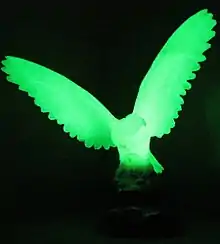Phosphorescence
Phosphorescence is a type of photoluminescence related to fluorescence. Unlike fluorescence, a phosphorescent material does not immediately re-emit the radiation it absorbs. The slower time scales of the re-emission are associated with "forbidden" energy state transitions in quantum mechanics. As these transitions occur very slowly in certain materials, absorbed radiation is re-emitted at a lower intensity for up to several hours after the original excitation.
Everyday examples of phosphorescent materials are the glow-in-the-dark toys, stickers, paint, wristwatch and clock dials that glow after being charged with a bright light such as in any normal reading or room light. Typically, the glow slowly fades out, sometimes within a few minutes or up to a few hours in a dark room.[1]
Around 1604, Vincenzo Casciarolo discovered a "lapis solaris" near Bologna, Italy. Once heated in an oxygen-rich furnace, it thereafter absorbed sunlight and glowed in the dark. The study of phosphorescent materials led to the discovery of radioactive decay.
Explanations
Simple

In simple terms, phosphorescence is a process in which energy absorbed by a substance is released relatively slowly in the form of light. This is in some cases the mechanism used for "glow-in-the-dark" materials which are "charged" by exposure to light. Unlike the relatively swift reactions in fluorescence, such as those seen in a common fluorescent tube, phosphorescent materials "store" absorbed energy for a longer time, as the processes required to re-emit energy occur less often.
Quantum mechanical

Most photoluminescent events, in which a chemical substrate absorbs and then re-emits a photon of light, are fast, in the order of 10 nanoseconds. Light is absorbed and emitted at these fast time scales in cases where the energy of the photons involved matches the available energy states and allowed transitions of the substrate. In the special case of phosphorescence, the electron which absorbed the photon (energy) undergoes an unusual intersystem crossing into an energy state of different (usually higher) spin multiplicity (see term symbol), usually a triplet state. As a result, the excited electron can become trapped in the triplet state with only "forbidden" transitions available to return to the lower energy singlet state. These transitions, although "forbidden", will still occur in quantum mechanics but are kinetically unfavored and thus progress at significantly slower time scales. Most phosphorescent compounds are still relatively fast emitters, with triplet lifetimes in the order of milliseconds. However, some compounds have triplet lifetimes up to minutes or even hours, allowing these substances to effectively store light energy in the form of very slowly degrading excited electron states. If the phosphorescent quantum yield is high, these substances will release significant amounts of light over long time scales, creating so-called "glow-in-the-dark" materials.
Chemiluminescence
Some examples of glow-in-the-dark materials do not glow by phosphorescence. For example, glow sticks glow due to a chemiluminescent process which is commonly mistaken for phosphorescence. In chemiluminescence, an excited state is created via a chemical reaction. The light emission tracks the kinetic progress of the underlying chemical reaction. The excited state will then transfer to a dye molecule, also known as a sensitizer or fluorophor, and subsequently fluoresce back to the ground state.
Materials
Common pigments used in phosphorescent materials include zinc sulfide and strontium aluminate. Use of zinc sulfide for safety related products dates back to the 1930s. However, the development of strontium aluminate, with a luminance approximately 10 times greater than zinc sulfide, has relegated most zinc sulfide based products to the novelty category. Strontium aluminate based pigments are now used in exit signs, pathway marking, and other safety related signage.[2]



- Phosphorescent pigments – zinc sulfide vs. strontium aluminate

 Pigments in the dark
Pigments in the dark Pigments in the dark after 4 min
Pigments in the dark after 4 min
- Phosphorescent
 Phosphorescent pigment red (calcium sulfide)
Phosphorescent pigment red (calcium sulfide) Phosphorescent pigment red in the dark
Phosphorescent pigment red in the dark Phosphorescent pigment blue (alkaline earth metal silicate )
Phosphorescent pigment blue (alkaline earth metal silicate ) Phosphorescent pigment blue in the dark
Phosphorescent pigment blue in the dark
Uses
In 1974 Becky Schroeder became one of the youngest females to be given a US patent for her invention of the "Glow Sheet" which used phosphorescent lines under writing paper to help people write in low-light conditions.[3]
Glow in the dark material is added to the plastic blend used in injection molds to make some disc golf discs, which allow the game to be played at night.
Shadow wall
A shadow wall is created when a light flashes upon a person or object in front of a phosphorescent screen which temporarily captures the shadow. The screen or wall is painted with a glow-in-the-dark product that contains phosphorescent compounds.[4] Publicly, these shadow walls can be found at certain science museums.[5][6]
 Before image of capturing a shadow on a phosphorescent wall.
Before image of capturing a shadow on a phosphorescent wall. After image of capturing a shadow on a phosphorescent wall.
After image of capturing a shadow on a phosphorescent wall.
See also
References
- Karl A. Franz, Wolfgang G. Kehr, Alfred Siggel, Jürgen Wieczoreck, and Waldemar Adam "Luminescent Materials" in Ullmann's Encyclopedia of Industrial Chemistry 2002, Wiley-VCH, Weinheim. doi:10.1002/14356007.a15_519
- Zitoun, D.; Bernaud, L.; Manteghetti, A. Microwave Synthesis of a Long-Lasting Phosphor. J. Chem. Educ. 2009, 86, 72-75.doi:10.1021/ed086p72
- Times, Stacy V. Jones Special to The New York (1974-08-17). "Girl Finds Way to Write in Dark". The New York Times. ISSN 0362-4331. Retrieved 2020-08-16.
- http://www.discoveriescience.com/Phosphorescence_Expoalration.pdf
- https://www.exploratorium.edu/exhibits/shadow-box
- http://glow.glowinc.com/shadow-wall/
External links
| Look up phosphorescence or glowing in Wiktionary, the free dictionary. |
